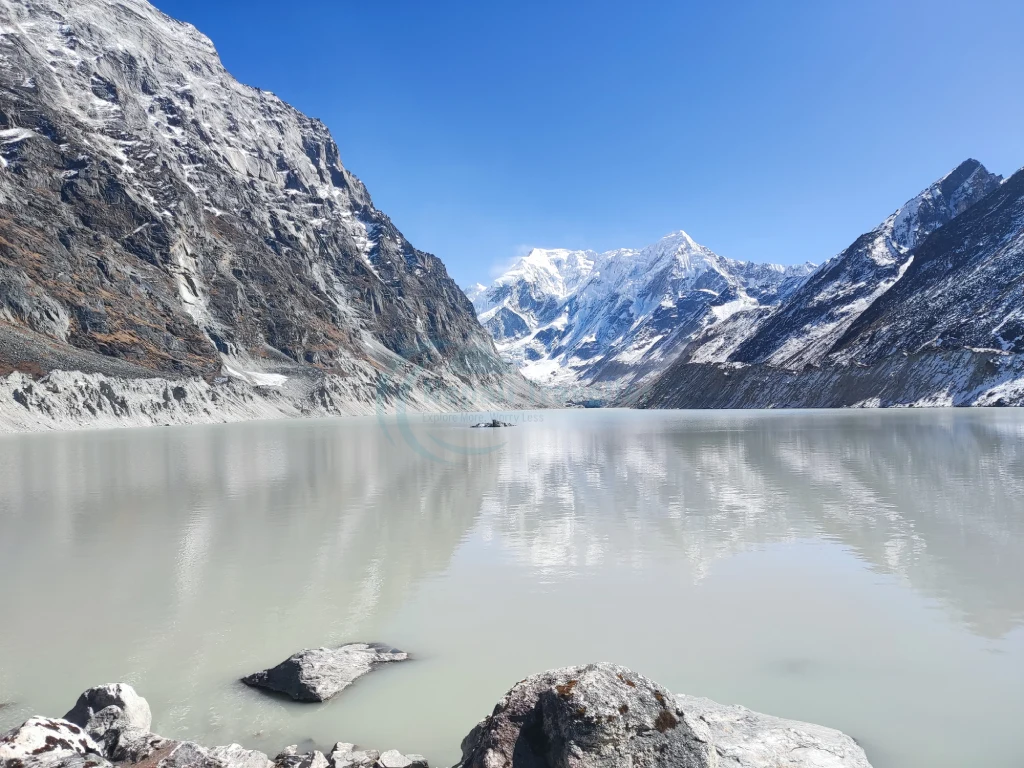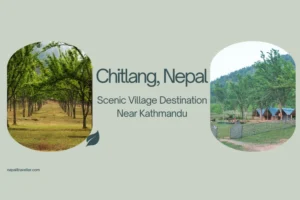Filled with natural beauty, cultural diversity, and spiritual significance, Rolwaling Valley of Nepal is the perfect destination for trekkers. The 6-day Tsho Rolpa and Dudhkunda trek through Rolwaling Valley is an alternative trek that takes you to two sacred glacial lakes: Tsho Rolpa (Nepal’s largest glacial lake) and Dudh Kunda (or ‘Milk Lake’). This trek will be a truly unique experience for trekkers looking for adventure, peace, and a greater connection with the Himalayas.
Table of Contents
ToggleTrek Overview
Duration: 6 days
Max Elevation: 4700 meters (Dudhkunda Lake)
Difficulty: Moderate / challenging
Best Season: March–May (spring) or September–November (autumn).
Starting Point: Chhetchet (public bus from Kathmandu)
Ending point: Gongar Khola to Kathmandu (bus)
Day to Day Itinerary
Day 1: Kathmandu to Chhetchet & Trek to Simigaun
Your journey begins with a scenic drive from Kathmandu to Chhetchet. The drive distance is about 7–8 hours by private vehicle or 10–12 hours by public bus. From Chhetchet, begin your 2-hour uphill trek to Simigaun, a Sherpa village where you will stay overnight. Along the trail, you will see terraced fields, thick forest, and the first of many views of the mighty
Day 2: Simigaun to Thangdin
Today your trek in the Rolwaling Valley continues through the villages of Surmuche and Kyalche. You will continue to ascend gradually through the valley, and eventually will enjoy stunning views as you near Beding. Due to the landslides in Dongang, we couldn’t reach to Beding as the way are diverted which is comparatively long route than before.
Since there are very few accommodation options in thangdin make sure there’s room available or you can book beforehand once you reach Kyalche.
Day 3: Thangdin to Na Village
A simple trek from Thangdin to Na Village, 4,180 meters. Today will be approximately 4 hours of trekking to reach the destination of Na Village. Beding will be the last major settlement before continuing on to the Lakes. It is important on this day to acclimatize to the elevation change, which can be problematic if not planned for correctly. The trek is steep, so it is very important to take your time, drink water, and rest as necessary. Na Village is a quiet place to be, with pretty views of the local peaks and glaciers.
Day 4: Na Village to Dudh Kunda and Tsho Rolpa Lake and Back to Beding
You will rise early today, and make your way to Dudh Kunda Lake (4,700 meters). The lake is about 2 hours away, and the milky-white lake is quite imposing with the snow-capped peaks surrounding it. After you have spent some time at the lake, you will make the trek from Dudh Kunda lake to Tsho Rolpa lake, spend some time in the largest Glacial lake in Nepal and back to Beding. Also, you can trek 1st to Tsho Rolpa lake and then Tsho Rolpa to Dudhkunda lake and back to Beding, for an arduous round trip of about 7-8 hours of trekking.

Day 5: Beding to Simigaun Trek
On this day, you’ll trek back to Simigaun after having breakfast in the morning which should take about 6-7 hours. You’ll begin your trek from Beding through the same trail that you come from. You can stop at the Kyalche for the launch and have some rest in Kyalche. Once you’ve eaten launch then you’ll descent to the Simigaun and spend a pleasing last night refreshing your memories during the trek.
Day 6: Trek to Gongar Khola & Return to Kathmandu
You will descend in early morning from Simigaun to Gongar Khola or Chetchet if you’re lucky enough, which should take about 2 hours of trekking. After finishing the descent you will board a bus back to Kathmandu marking the end of your 6-day adventure.
Trek Highlights
- Tsho Rolpa Lake: At the altitude of 4,580 meters, Tsho Rolpa is the largest glacial lake in Nepal. The lake is the result of thawing from the Trakarding Glacier and is surrounded by some extraordinary peaks making for a special view. The location is picturesque and peaceful .
- Dudhkunda Lake: Also known as ‘Milk Lake’, Dudhkunda is a holy site for both Buddhists and Hindus. The milky-white waters of the Dudh Kunda create a peaceful and mystical landscape of snow capped mountains.
- Cultural Experience: Along the way, the trek passes through Sherpa villages like Simigaun, Beding, and Na, which were made for culturally immersing oneself in the hospitality, culture, and traditions of the Sherpa people.
- Scenic Beauty: The trail provides stunning vistas of magnificent mountain ranges including Gauri Shankar (7,145m), Melungtse (7,181m), and Chukyima Go (6,685m), also showcasing an exceptional mix of landscapes from beautiful flourishing forests and highs of alpine meadows.
Flora and Fauna
The Rolwaling Valley is bursting with biodiversity. The valley consists of forests containing rich rhododendron, pine, and oak trees, as well as an abundance of birds, animals, and rare plants. You might spot wildlife, including musk deer, Himalayan tahr, and the elusive snow leopard. You might get lucky spotting a birdwatching prize like the Himalayan griffon vulture and the red panda elevating it into an even more magical journey.
Trekking Tips
- Permits: To trek the Rolwaling Valley, you need to obtain a TIMS (Trekkers’ Information Management System) card and a national park permit.
- Acclimatization: It is essential that you take proper time to acclimatize to higher altitudes. Be sure to take it easy on the trek, stay hydrated, and rest when you feel necessary to avoid altitude sickness.
- Packing Essentials: Warm clothes, proper trekking boots, rain coat, sun protection, and snacks. It is good to have a plastic rain coat too, since the weather is unpredictable.
- Guides and Porters: Hiring a local guide and porter adds value to your trek by providing local knowledge and carrying your stuff.
Budget Estimate
The Tsho Rolpa and dudhkunda trek is budget friendly. Nepali Trekkers typically spend NPR 10,000 to 12,000 for the entire trek including permits, accommodation, meals and transport while the cost may increase for the foreign trekkers. There will be higher costs when you reach Na Village, given it’s remoteness, but it is overall a budget friendly trek for the experience.
Conclusion
The Tsho Rolpa and Dudhkunda trek has everything from stunning natural beauty, cultural experiences and spiritual significance. The trek allows you to leave the crowded trails and provides the opportunity to experience Himalayan Nepal, a less-travelled area rather than the more common places and was an unforgettable trek for us. Regardless if you are an experienced trekker seeking a challenge or adventurous individual wishing to connect with nature and culture; the trek is guaranteed entertainment.
If you plan on having your next Himalayan adventure, and are looking for the best trekking experience in Nepal, consider the Tsho Rolpa and Dudh Kunda lake trek.
FAQs
1. Do I need a guide for Tsho Rolpa and Dudh Kunda trek?
Although you can do the trek independently, it is highly recommended that you have a guide. This is particularly important if you have not trekked in the Rolwaling region before. The trails are remote and lack clarity in signage, so having a local guide will be even more effective for navigation, especially when you need to communicate with villages and if you need any local-specific safety consideration during high altitude trekking. If you can hire a porter to help lighten your load, this will not only help you physically, but it will also help you feel more comfortable on your journey.
2. What is the best season to trek to Tsho Rolpa and Dudhkunda?
The best time to trek is in the spring from March to May, and in autumn from September to November. During these types of season, you can expect clearer skies, pleasant temperatures, and plenty of visibility of the surrounding peaks. The summer monsoon season, between June to August, produces torrential rain that can turn trials into slippery mud and the risk of landslides increases greatly. Winter from December to February is typically extremely cold and path snow coverage is very likely.
3. Is altitude sickness a risk on this trek?
Altitude sickness is definitely a risk. It is more of a risk on this trek because the trek goes rapidly over 4,000 meters. Both Tsho Rolpa (4,580m) and Dudh Kunda Lake (4,700m) are at high altitude. Common symptoms of altitude sickness are: headache, nausea, dizziness and fatigue. To reduce the risk:
- Acclimatize properly with a gradual ascent.
- Stay hydrated and avoid alcohol.
- Descend immediately if symptoms worsen.






